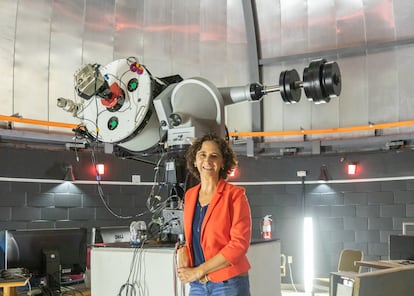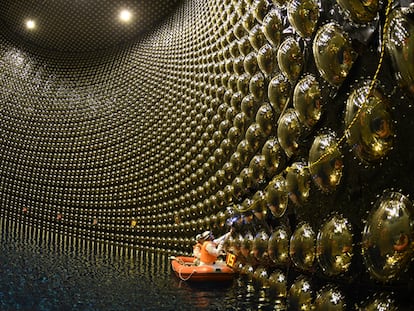The Spanish astronomer set to explore the largest and most mysterious reaches of the Solar System
Noemí Pinilla-Alonso is leading two major programs using the biggest space telescope in history, the James Webb

Hailing from Oviedo in the northern region of Asturias, Noemí Pinilla-Alonso says that as a child, contemplating the stars was hard to do as it was almost always cloudy. However, every summer her family went to Toro, in Zamora, where her parents, a salesman and a teacher, grew up. There, the “Castile skies” allowed her to discover her first constellations.
That little girl is now 50 and, as an astronomer at the Space Institute of Central Florida University, she is leading one of the most ambitious investigations into the outer reaches of our Solar System to date; using the James Webb space telescope she and her team will explore what lies beyond Neptune, the last planet in our Solar System.
Pinilla-Alonso’s life was changed forever by one of the biggest astronomical controversies this century: the discovery of a number of distant bodies larger than the dwarf planet Pluto that led to intense international debate.
For the first time, the largest space telescope in history will be able to scrutinize some of these bodies – namely Eris, Make Make and Haumea – and observe whether they have the basic ingredients for life. Thanks to the Webb telescope, Pinilla-Alonso will also be able to explore the unknown moons of Uranus: Ariel, Umbriel, Titania and Oberon. But the thrust of her venture is to study the trans-Neptunian bodies, a vast ring of millions of unknown objects that extends beyond the planet of Neptune.
Question. Why go beyond Neptune?
Answer. Trans-Neptunian objects form one of the largest yet least-known structures in the Solar System. We are aware that this belt of icy objects beyond Neptune is where comets emerge from. We know that this belt contains large objects like Pluto, about 2,000 kilometers in diameter, and smaller ones, less than 10 kilometers. There may be trillions of them, although so far we only know of 3,000. We have no idea what their surface consists of. Water has been detected, but we do not know how much there is. Nor do we know if this is the most abundant element or if there is also ice composed of methane, methanol, nitrogen or carbon dioxide. And that is very important because those are the seeds of life.
Q. Can life on Earth have its origin in these bodies?
A. That’s right. In comets, ice is turned into gas and dust. That is why we know that they contain compounds such as methanol and carbon monoxide, key elements for life. During the Solar System’s most chaotic periods, there was an echo between Jupiter and Saturn. Each orbited around the Sun in its own way, but at one point they became gravitationally connected and moved in a coordinated manner. They are the two largest planets and they began to move in unison, sweeping everything around them aside, and ejecting smaller bodies, like a huge billiard ball. Many of these bodies were sent either into the Solar System or outwards. At that time there were many, many collisions with the Moon and the Earth. And that may have been when iced water and organic compounds reached our planet and we got the very beginnings of life. These two giant planets also caused Uranus and Neptune to migrate to the outer reaches of the Solar System. And they, in turn, swept the outer zones. It is thought that in their original state, all trans-Neptunian objects were 10 times larger than Earth. But most of them disappeared. Now only about 10% is left. What we want to know are the details of what happened.
Q. Why is the James Webb Telescope so important to the study of these objects?
A. As clichéd as it sounds, there are a lot of unanswered questions when it comes to our knowledge of the Solar System. For example, we do not fully understand how it was formed, or much about the planetesimals – the fragments that could join together to form the planets. Theories attempting to explain it only partially succeed. The James Webb is a large space telescope that can observe the infrared universe. That means it will reveal a universe that has been hidden until now. On the subject of trans-Neptunian objects, it will show us the materials that form them. This will allow us to examine the processes that have affected them from the moment they were formed billions of years ago to the present day.
We are far more blind to dangerous asteroids since the Arecibo telescope was dismantled
Q. Couldn’t we do it with ground-based telescopes?
A. Since the first trans-Neptunian object besides Pluto was discovered in 1992, many more of these bodies have been detected. Seen from Earth, they are not very bright and the data we can obtain with ground-based telescopes is limited. Recently, we have discovered that there are not only larger bodies, but also smaller, dimmer bodies in which water is mixed with other materials. But it is impossible to identify these materials from the ground. We assume that those that are very red have complex organics – those key compounds for life – but we need to confirm this and we will be able to do this with Webb.
Q. What objects are you going to focus on?
A. NASA’s New Horizons probe has shown us the surface of Pluto in detail. It has shown that this dwarf planet has an atmosphere and that there is material transfer on the surface. We know the extent of its glaciers, craters and ice deposits. Conversely, other even larger objects are largely unknown. We now have almost 100 hours of guaranteed time with Webb to observe the largest trans-Neptunians: Eris, Make Make and Haumea, as well as Pluto and Charon.
Q. Will you be able to expand what we know of smaller bodies?
A. Yes, we have another project for that. With the few trans-Neptunians that have been observed so far, we know that there is a lot of diversity – objects as dark as asteroids that must be made of carbon and others as bright as freshly fallen snow, like Haumea. To know what is in this belt we have to study very different objects; we will study 60 of them.
Q. Could these studies reveal the existence of a new planet on the fringes of our Solar System?
A. Right now there are two approaches regarding this planet X. One group continues to study the most distant trans-Neptunians to see if their orbits are aligned and are influenced by that distant planet while another group thinks there is no such alignment and that many more such objects need to be discovered and observed in order to explore their behavior. The James Webb telescope is not the right tool to search for or discover planets in our Solar System because its field of vision is limited. However, it would be the ideal tool to study its surface if another telescope, such as the Vera Rubin telescope, which will be scanning the entire sky in the next decade, were to discover it.
Q. You were a principal investigator at Arecibo, the largest radio telescope in the world, which has now been dismantled. Is there any way it can be salvaged?
It’s hard to imagine there is no life beyond Earth
A. This observatory has been unique in the history of science. Not only was it the largest radio telescope in the world, but it was also very versatile. Its original antenna was complemented by many others that made it the most powerful tool not only in radio astronomy, but also in the study of our own atmosphere, the ionosphere, and as a huge radar to support NASA’s planetary coordination defense office. The censuses discovered potentially dangerous asteroids and Arecibo pointed its radar and allowed us to calculate their orbit with great precision. We knew if they were dangerous and when the next ones would be coming towards our planet.
Q. So, are we a little more blind now to dangerous asteroids?
A. We have become much blinder. Right now we pretty much only have the NASA Goldstone antenna, which is much smaller. We can only identify the larger, closer objects. All the asteroids that could catastrophically destroy the Earth are already mapped, but there are many more that could destroy entire cities that are not.
Q. Do you believe there is life beyond Earth? If so, where are we most likely to find it?
A. There is no proof, but it’s hard to imagine there isn’t. There are so many stars, so many galaxies that there must be life in some of them. The question is whether we are able to discover it. That’s why we have to continue collecting data, observing and investing in the search for signs that we think were the origins of life on Earth. We must find disks with materials similar to ours. There is also the technological traces project, which is based on tracking the universe to see if we are receiving any signal, made by a possible civilization.
Q. Do you believe such signals exist?
A. It’s interesting. We can’t ignore the possibility.
Tu suscripción se está usando en otro dispositivo
¿Quieres añadir otro usuario a tu suscripción?
Si continúas leyendo en este dispositivo, no se podrá leer en el otro.
FlechaTu suscripción se está usando en otro dispositivo y solo puedes acceder a EL PAÍS desde un dispositivo a la vez.
Si quieres compartir tu cuenta, cambia tu suscripción a la modalidad Premium, así podrás añadir otro usuario. Cada uno accederá con su propia cuenta de email, lo que os permitirá personalizar vuestra experiencia en EL PAÍS.
¿Tienes una suscripción de empresa? Accede aquí para contratar más cuentas.
En el caso de no saber quién está usando tu cuenta, te recomendamos cambiar tu contraseña aquí.
Si decides continuar compartiendo tu cuenta, este mensaje se mostrará en tu dispositivo y en el de la otra persona que está usando tu cuenta de forma indefinida, afectando a tu experiencia de lectura. Puedes consultar aquí los términos y condiciones de la suscripción digital.
More information
Archived In
Últimas noticias
Most viewed
- Reinhard Genzel, Nobel laureate in physics: ‘One-minute videos will never give you the truth’
- Oona Chaplin: ‘I told James Cameron that I was living in a treehouse and starting a permaculture project with a friend’
- Pablo Escobar’s hippos: A serious environmental problem, 40 years on
- Chevy Chase, the beloved comedian who was a monster off camera: ‘Not everyone hated him, just the people who’ve worked with him’
- Why we lost the habit of sleeping in two segments and how that changed our sense of time











































